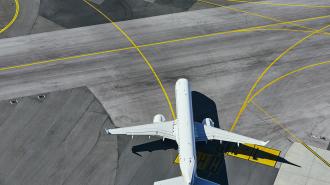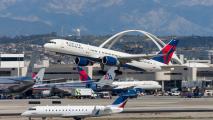Major airports across the US have added a new piece of software that will alert air traffic controllers if a plane appears to be lining up to land on a taxiway — essentially the ground roads for airplanes that connect runways, terminals, and hangars.
Taxiway landings — called “wrong surface events” — could end in disaster, as the rapidly incoming plane risks hitting those taxing on the ground.
There were 1,641 wrong surface events from October 2016 to the end of 2022, the FAA told Axios.
The lion’s share of those erroneous landings fell under general aviation (think private prop planes, corporate jets, and agricultural aircraft), but commercial jets have accidentally landed on taxiways, too — perhaps most infamously in 2006, when a Continental-operated 757 landed at Newark Liberty International.
Major airports across the US have added a new piece of software that will alert air traffic controllers if a plane appears to be lining up to land on a taxiway.
In 2017, an Air Canada flight almost landed on a taxiway at San Francisco International Airport already crowded with four other planes awaiting takeoff — a potentially massive tragedy averted.
The new system, called ASDE-X Taxiway Arrival Prediction (ATAP), has thus far been installed in 43 airports, including Chicago O’Hare, Boston Logan, LAX, and Phoenix’s delightfully named Sky Harbor, according to data from an FAA blog post. (Check out if your next departure or destination has it!)
Taxiway vs. runway: Aircraft use taxiways to travel to and from runways and other facilities, like terminals or hangars. When you’re rolling along before takeoff or trundling to the jetway, you’re on a taxiway.
Runways, used for takeoff and landing, are clearly marked — large numbers, striped “piano key” boundaries, and unique lighting at night are all meant to help runways be clearly demarcated.
But taxiways can often be found running parallel to runways, and pilots can sometimes mistake the two. Planes accidentally landing on taxiways is considered one of the organization’s top 5 hazards in the national airspace system.
“ATAP provides an extra layer of safety for pilots and passengers at airports with multiple parallel runways and taxiways,” Jeffrey Sedin, airport ground environment chairman with the Air Line Pilots Association, said in the FAA post.
The system works works by detecting if a plane seems headed for a taxiway, then sending a visible and audible alert to air traffic controllers.
Averting taxiway trouble: ATAP works by using radar and a suite of other sensors to detect if a plane seems headed for a taxiway. The system then sends a visible and audible alert to air traffic controllers, who can then notify the pilots.
“ATAP is a great technology aid to assist controllers in mitigating these events, and has proven to be effective,” said Bridget Singratanakul, a runway safety representative for the National Air Traffic Controllers Association.
Since being installed at Seattle-Tacoma in 2018, ATAP has prevented 50 wrong surface events, the FAA said, and eight alerts have already been registered this year.
Planes as small as a Cessna Caravan 208 and as large as a Boeing 757 have been warned off a taxiway landing by ATAP, according to Giovanni Dipierro, the former manager of the FAA’s Runway Safety Group.
“All saves are equal,” Dipierro said.
The system was added to airports which have the ASDE-X or ASSC ground radar systems; the FAA is currently developing a taxiway alert for airports without the systems, due for testing in 2023 in Omaha.
We’d love to hear from you! If you have a comment about this article or if you have a tip for a future Freethink story, please email us at tips@freethink.com.






